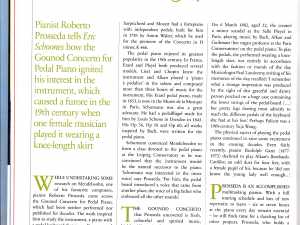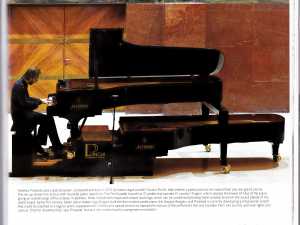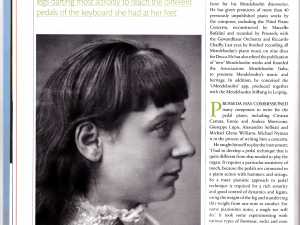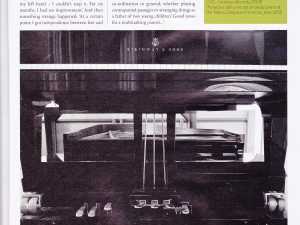1 luglio 2014 International Piano
The Multitasking Pianist
While undertaking some research on Mendelssohn, one of his favourite composers, pianist Roberto Prosseda came across the Gounod Concerto for Pedal Piano, which had been neither performed nor published for decades. The work inspired him to study the instrument, a piano with a pedal keyboard that is usually connected to a second set of hammers and strings. As the music critic Norman Lebrecht has written: ‘It’s a piano that thinks, deep down, it’s an organ.’
The instrument dates back around 550 years and shares its history with ancestors including the pedal clavichord and the pedal harpsichord. Many well known composers used the pedal keyboard: JS Bach owned a pedal harpsichord and Mozart had a fortepiano with independent pedals, built for him in 1785 by Anton Walter, which he used for the premiere of the Concerto in D minor, K 466. The pedal piano enjoyed its greatest popularity in the 19th century. In France, Erard and Pleyel both produced several models. Liszt and Chopin knew the instrument and Alkan played a ‘piano à pédalier’ in the salons and composed more than three hours of music for the instrument. His Erard pedal piano, made in 1853, is now in the Musée de la Musique in Paris. Schumann was also a great advocate. He had a pedalflügel made for him by Louis Schone in Dresden in 1843. His Op 56, Op 58 and Op 60, all works inspired by Bach, were written for the pedal piano. Schumann convinced Mendelsssohn to form a class devoted to the pedal piano at the Leipzig Conservatory as he was convinced that the instrument would be the natural successor to the piano. ‘Schumann was interested in the inner voice,’ says Prosseda. ‘For him, the pedal board introduced a voice that came from another place, the voice of a big father who embraced all the other sounds.’
The Gounod concerto that Prosseda uncovered is fresh, colourful and spirited music, highly idiomatic for the instrument. After he had stopped writing opera, Gounod wrote four works for pedal piano and orchestra. ‘Gounod is very good at drawing out the dramatic and gestural potential of the pedal piano,’ says Prosseda. ‘It’s a very dialectic relationship between the feet and hands.’ Gounod’s interest in the instrument was raised by the young pianist Lucie Palicot. On 6 March 1882, aged 22, she created a minor scandal at the Salle Pleyel in Paris, playing music by Bach, Alkan and Guilmant (her organ professor at the Paris Conservatoire) on the pedal piano. To play the pedals, she performed wearing a kneelength skirt, not entirely in accordance with the fashion or morals of the day. Musicologist Paul Landormy, writing of his memories of the day, recalled: ‘I remember what a strange impression was produced by the sight of this graceful and dainty person perched on a huge case containing the lower strings of the pedal-board […] her pretty legs darting most adroitly to reach the different pedals of the keyboard she had at her feet.’ Perhaps Palicot was a 19th-century Yuja Wang. The physical aspect of playing the pedal piano continued to raise some excitement in the ensuing decades. Even fairly recently, pianist Rudolph Ganz (1877-1972) declined to play Alkan’s Bombardo-Carillon, an odd duet for four feet, with a female pupil of his, because he ‘did not know the young lady well enough…’
Prosseda is an accomplished multitasking pianist. With a full touring schedule and lots of new repertoire to learn – six or seven hours at the piano every day remain essential – he still finds time for a dazzling list of other projects. Prosseda, who holds a PhD in Italian literature, has produced documentaries, published a listening guide to the piano repertoire with Edizioni Curci in Milan, contributes articles on classical and contemporary music to several music journals and is also a frequent host on Italian national radio: ‘I do everything better when I combine many different things,’ he says. ‘As my teacher Charles Rosen once said: “I needed to write those books to become a better pianist.”’
Prosseda is also the founder of Donatori di Musica, a network of volunteer doctors and musicians that organises concerts in the oncology departments of Italian hospitals. He says: ‘I saw the miraculous effects when my friend and CD producer Gian Andrea Lodovici was diagnosed with cancer, and he organised a series of concerts in the hospital. Doctors, nurses, patients and their families were able to meet informally and playing there was an incredible experience for me. You forget about your ego and focus on sharing the beauty of music. Now, at regular concerts, I try to regain that feeling.’
In 2012, Prosseda embarked on another daring and innovative project together with Teo Tronico, a robot with 53 fingers that can play any work from the piano repertoire on any normal piano. The robot played Chopin’s Polonaise Op 22 with the Berlin Symphony Orchestra, with Prosseda as a ‘ghost’ pianist playing a digital piano backstage. ‘This brings interesting insights for the public into the human element of performance and the differences between reproduction and interpretation, going beyond what is written in the score,’ he says. ‘It also triggers young people to listen to music.’
Early in his career, Prosseda championed neglected composers for the piano such as Salieri, Rossini and Caetani. He has also recorded the complete piano works of Luigi Dallapiccola and Goffredo Petrassi. Since 2004, he has gained international fame for his Mendelssohn discoveries. He has given premieres of more than 40 previously unpublished piano works by the composer, including the Third Piano Concerto, reconstructed by Marcello Bufalini and recorded by Prosseda with the Gewandhaus Orchestra and Riccardo Chailly. Last year, he finished recording all Mendelssohn’s piano music on nine discs for Decca. He has also edited the publication of ‘new’ Mendelssohn works and founded the Associazione Mendelssohn Italia, to promote Mendelssohn’s music and heritage. In addition, he conceived the ‘i-Mendelssohn’ app, produced together with the Mendelssohn Stiftung in Leipzig.
Prosseda has commissioned many composers to write for the pedal piano, including Cristian Carrara, Ennio and Andrea Morricone, Giuseppe Lupis, Alessandro Solbiati and Michael Glenn Williams. Michael Nyman is in the process of writing him a concerto. He taught himself to play the instrument: ‘I had to develop a pedal technique that is quite different from that needed to play the organ. It requires a particular sensitivity of touch, because the pedals are connected to a piano action with hammers and strings. So a more pianistic approach to pedal technique is required for a rich sonority and good control of dynamics and legato, using the weight of the leg and transferring this weight from one note to another. For some pianissimo notes, a single toe will do.’ It took some experimenting with various types of footwear, socks and even jazz dance shoes before he settled on a shoe designed for yoga and Pilates. The hands are also required to play differently from on a normal piano, as the player’s balance and seating position are often altered by the constant movement of the legs. The sustaining pedal is seldom used, as both feet are simply too busy playing the pedal board. Therefore, the general sound is dryer and more transparent than from a normal piano, and this is probably a specific feature that Gounod and Alkan wanted for their pedal piano music.
When Prosseda first started practising on a vintage Pfeiffer upright pedal piano from 1906, playing with the feet proved very demanding: ‘Whatever I did with my feet was automatically replicated by my left hand – I couldn’t stop it. For six months, I had no improvement.’ And then something strange happened: ‘At a certain point, I got independence between feet and left hand, and when I did, I felt as if two more channels had opened in my brain. Playing the normal piano now, with two hands, seems much easier. I can also see the structure of music more clearly. I can colour separate voices in polyphonic music more clearly, and last but not least, my memory has improved and I learn new pieces much faster. It has improved my sense of co-ordination in general, whether playing contrapuntal passages or arranging things as a father of two young children.’ Good news for a multitasking pianist.






